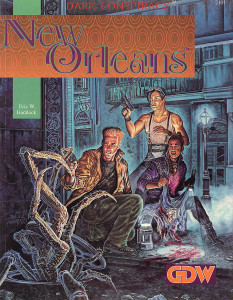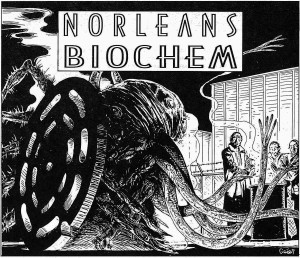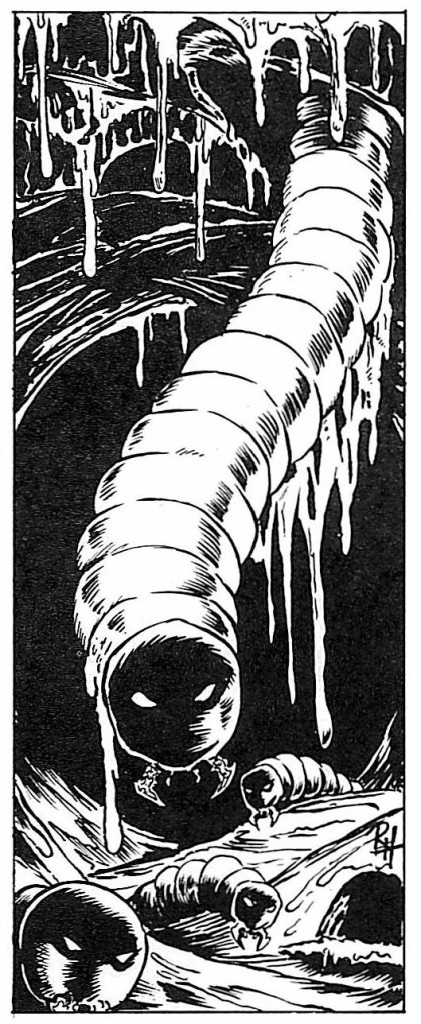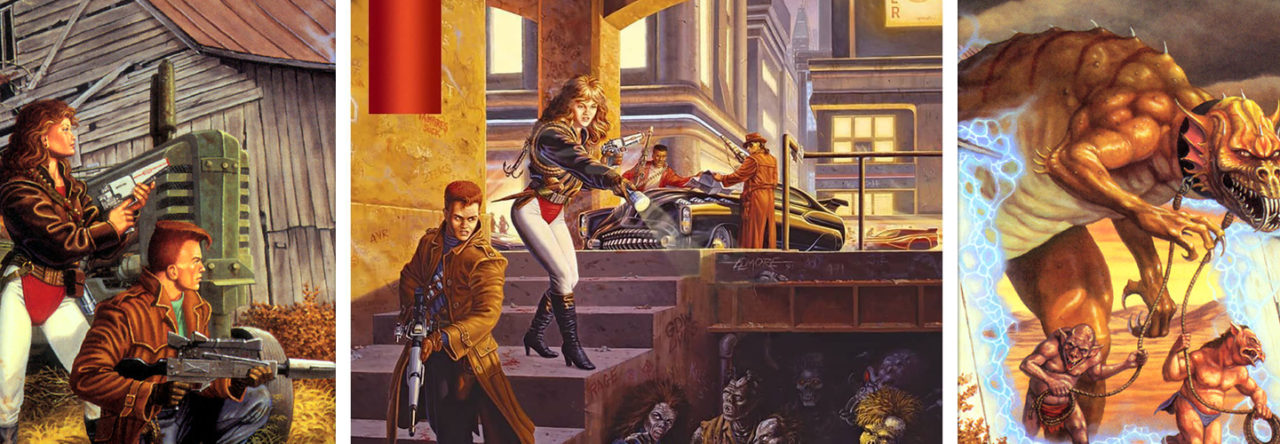Written by Eric W. Haddock (1991, GDW)
 New Orleans hit the shelves in 1991 as the first book produced by Game Designers Workshop (GDW) in support of their new Dark Conspiracy game-line. More than simply an adventure, New Orleans is part scenario, part city supplement, and in many ways the blueprint for the books that were to follow.
New Orleans hit the shelves in 1991 as the first book produced by Game Designers Workshop (GDW) in support of their new Dark Conspiracy game-line. More than simply an adventure, New Orleans is part scenario, part city supplement, and in many ways the blueprint for the books that were to follow.
Note that this review accompanies an interview darkconspiracytherpg.info conducted with the author of this supplement, Eric Haddock. This can be found here – [Interview] Eric Haddock – Author of New Orleans
As with all of GDW’s products, the layout and art is of the highest quality, with a stunningly and provocative cover piece, and more cartography than I think I’ve seen in anything outside of a D&D adventure. Better still, the product presents the type of scenario (both at a structural level and in the detail) that I prefer to read and write – an open world with enough material to provide for many sessions of play. New Orleans isn’t perfect, and there are certainty places were the author glosses over the in-game transitions or skips investigative details that could well have improved the entire product, but with limited page space and an intricate plot to establish this can be forgiven.
Divided into 10 main sections, these are a combination of both setting material (focusing on the city of New Orleans) and actual scenario details. It is important to highlight that unlike adventures you might find with other roleplaying games, there is little narrative flow between these sections. Instead, each chapter simply introduces an element of the city or a specific location and the events that can occur there in; little in the way of advice on how the scenes themselves will play out. This approach, while working well to highlight the core framework of the scenario, relies heavily on a proactive Referee to manage the behaviours of various opposing forces, as well as determine how each group responds to the introduction of the threat posed by the Minion Hunters. While an experienced Referee might find this style liberating, more novice Game Masters may well be a little lost by such an open scenario style.
The Hook
Like many such adventures, the Minion Hunters are drawn into New Orleans via a mutual friend; in this case an old colleague or acquaintance by the name of Louis Rogers. Lou, who knows of one or more of the characters’ exploits, calls on the group when he finds himself neck deep in a conspiracy to dump chemical waste in swamp outside of New Orleans. (A synopsis of the scenario and details on just how the group might get to Lou are covered in the first chapter, A Letter From Lou.)
Unfortunately, Lou is not around when the Minion Hunters arrive, but very quickly it comes obvious that something very sinister is taking place in his neighbourhood. So begins the mystery, with the characters tracking down the various leads left behind by their friend and what is revealed to be many layers of a dark conspiracy. This is a nice and simple hook, and one that drives the characters forward, even if the leads start a bit too thin.
Where is Lou? This initial investigative driver is reinforced throughout the scenario both when the Minion Hunters discover more about his place of work – Norleans Biochem – and again when the troubles within the New Orleans swamp are introduced. The combination of this layered approach, I feel, keeps the players interested and deepens the mystery with every step, and is a good piece of scenario design.
The Chase
The first sections of the New Orleans focus more on the setting and situation within New Orleans, and as such I’ll return to these below. The scenario proper, however, begins with chapter four – Lou’s Neighbourhood. Here we are introduced to what middleclass life in New Orleans and reveals that, with little security of police to call on the community is a threatened by things from below. This section really acts as a lead-in to the rest of the story, adding the opportunity to explore in the sewers beneath New Orleans and introducing interesting NPCs that could be used as reoccurring characters or even replacement Minion Hunters, if required.

Evil Beneath details the group’s journey in to the sewers. Most likely the first real chance the Minion Hunters will have to encounter any real threat, this section is a smorgasbord of horrors and evil that even an experience roleplayer might find disturbing. From alien grubs feeding on corpses, through to tunnels of human limbs, this is a great series of locations that most horror Referee’s will love throwing at their party. The only downside, I have to say, is that while this is all great ‘fodder’ for a horror game, there is no real pay-off for the players getting involved in this portion of the story, and nor does the scenario ever really explain what these horrors are doing deep underground. Still, it definitely illustrates to the players that they are in for one hell of an experience as the rest of the plot unfolds, and will have them scratching their heads as it poses a lot more questions than it answers in terms of what is really going on in New Orleans.
Norleans Biochem – the company Lou worked for and was suspicious about – is detailed next. It seems that even a corporation as powerful and influential as Norleans Biochem, is not immune to the horrors haunting the city, and it is soon revealed that these might actually be the result of their own suspicious actions. With a bit of streetwise and charisma, the Minion Hunters learn that Norleans Biochem is most definitely dumping hazardous waste in the swamp, right into the main water supply that provides for the entire city! While this is bad enough, those finding their way into the corporation’s headquarters will discover that no simple human mastermind is behind the plot, but rather a group of Insectoid ETs are in charge and are using its power and influence to further their own means.
While not an essential part of the plot, infiltrating of the upper floors of Norleans Biochem’s headquarters reveals more of the alien threat, and in style reminds me of the similar scenes from Mike Stackpole’s A Gathering Evil (the first Dark Conspiracy novel). It goes to show that strange devices, nefarious plots and otherworldly ETs are the heart of the Dark Conspiracy game!
What is important from their snooping, however, is that the group is drawn out to the Lake Maurepas Pumping Station, which is the next section of the adventure. It is here that Norleans Biochem is dumping the toxins into New Orleans’ water system, although why is not yet revealed. As written the characters should arrive in time to witness (yet another) attack on the plant, which while horrific again doesn’t really explain much about what is going on. What is important is that the actions of Norleans Biochem and the seemingly continuous assaults upon their property should draw the Minion Hunters further into the nearby swamp.
The Swamps is probably the best written, if not the most interesting, section of the entire New Orleans adventure. This chapter explores the real evil plaguing the city, the Nexus of Evil, and explains why Norleans Biochem has devoted so much effort to the poisoning of the region.
Broken into a number of sub-sections, this section covers not only the swamp in general – a dark and foreboding place at best – but also details a number of encounters that the Minion Hunters can stumbled across as they explore the wetlands. These range in scope from concerned scientists through to helpful hunters, and include a memorable meeting with a man who is well on the way to becoming a Moss Zombie. This last encounter is just the sort of thing that makes me tingle as a Dark Conspiracy Referee, as it provides just the right amount of tension mixed in with a good dose of fatalism to make a scene stand out from any other.
Back to our erstwhile heroes, however, it is not until they met the local Cajun population – a rough and ready collection of traditional swamp dwellers and a sprinkling of folk affected by the Greater Depression – that the true horror of the adventure is revealed. These locals have discovered that a great evil has taken root in the heart of their swamp, and with the Minion Hunters help, want to defeat it. This final conflict – The Nexus of Evil – takes place in the old Bouchard Mansion. Unfortunately, for all the build-up and work done to this point of the adventure, this final climactic chapter is a bit of a let-down.
After the initial exploration in the basement of the abandoned house, the structure quickly turns into a bit of a ‘dungeon crawl’, as the characters, sneak, shoot or blast their way through the Nexus’ hidden underground lair (which comes complete with Zombie guards and the obligatory Dimension Walk Device). Eventually all this D&D-like room descriptions leads to the Nexus itself, a writhing mass of tentacles and plant matter. While posing some considerable threat to the characters, in the end it is likely that this confrontation will spiral into a bit of a shooting gallery, as the Minion Hunters and their allies try and whittle down the creature’s enormous number of hit points while holding off the seemingly endless horde of zombie minions.
The threat defeated, Ending the Adventure, details the possible outcomes of the scenario, the character rewards and the potential for further stories that may result from their interference in the city. While brief, this section does open up a world of possibilities for a resourceful Referee, and means that New Orleans will be more than just a ‘one shot’ affair.
Extras
 As with other Dark Conspiracy adventures, New Orleans devotes considerable space to supplementary material that can be used to enhance the scenario and really bring the setting to life. In this case this extra detail is divided into two distinct sections; New Orleans Metroplex in the front of the book, and Referee Resources at the end.
As with other Dark Conspiracy adventures, New Orleans devotes considerable space to supplementary material that can be used to enhance the scenario and really bring the setting to life. In this case this extra detail is divided into two distinct sections; New Orleans Metroplex in the front of the book, and Referee Resources at the end.
New Orleans Metroplex is a player friendly introduction to New Orleans as seen through the eyes of Dark Conspiracy. This includes a brief breakdown of the population and class structure within the city, its geographical boundaries, and its politics. Perhaps the most interesting portion of this section, however, is the discussion on New Orleans’ weather. Mother Nature hasn’t been kind to ‘The Big Easy’, with extreme heat and a UV hole that renders a person blind within a day if the proper protection isn’t used. It is little things like this that makes a reader realise just how horrible the Dark Conspiracy Future can be!
The Referee Resources is a vital addition to those wanting to know how the situation in New Orleans came about. From the true origin of the Nexus of Evil, through to the rise in the conflict between this ‘monster’ and the Insectoid ETs, this is information probably should have appeared early in the adventure. Nevertheless, here it gives the Referee yet more details upon the setting and motivations of the key antagonists and will allow them to create their own customised version of New Orleans. This chapter also introduces a new Empathic power used by Nexus of Evil, Cryokinesis (the power over cold), and details the various minions and creatures the Minion Hunters may encounter in their quest.
Opinions
On first impressions it feels as if New Orleans is not exactly a complete adventure. I say that in a positive was as really this book is probably more of an overview too something much larger and much more sinister than could ever be produced under the GDW publishing model. When looking at New Orleans, I’m convinced that you’re really only looking a portion of a much larger campaign, one that author envisioned spanning a much great depth. Given the format and structure in which New Orleans was produced, I believe it is an open invite for Dark Conspiracy Referees to create their own world from this ‘cut cloth’.
While at its core, New Orleans is the conflict between the Nexus of Evil and Norleans Biochem, I can easily see how this scenario can morph into a setting in which a larger campaign could be run. Here the story that begins with the investigation of Biochem and latterly the Louisiana swamps could simply be intermingled with other, more immediately pressing adventures (such as Charles E. Gannon’s Gnawlings scenario from Issue 56 of Challenge Magazine). In such a way the New Orleans framework becomes an overarching campaign setting, that sees the Minion Hunters come into the city as its saviour… or perhaps as bringer of a untold doom!
The potential of New Orleans is almost boundless…
That’s not say that as a self-contained scenario it is without it failings. It does feel very linear in places, and often there is only a single, often tenuous lead, to drive the story onwards (such as when the Minion Hunters are supposed to follow a Norleans Biochem executive after the attack at the Pump station, or when only a single NPC is listed as providing vital information about the actions of the chemical company). It also has a tendency to skip over the transitional scenes; how the characters progress from scene to scene.
I suppose also that New Orleans is a produce of its age presenting, as scenarios often did in the late 80s and early 90s a very rigid, room by room description approach to some of its set locations, Norleans Biochem’s Headquarters and the Nexus’ Bouchard Mansion being the most chiding. Here the simple ‘what’s in the room’ descriptions makes one feel as though you’re stuck in a Dungeons & Dragons adventure. Compare this to the section on the swamp, with its varied encounters, and detailed but open locations and you quickly get an idea what these two ‘simpler’ settings could have been like if a little more creativity had been applied to them.
This goes doubly so for the worse section in the scenario – the Lake Maurepas Pumping Station. Not only does this chapter fail to add anything to the adventure – except the aforementioned single lead – it presents an odd, even implausible battle that involves the Nexus’ mind controlled Harpies and Cobra men. I’ll point out that this is the only time in the whole book these to minions species are mention, and don’t even appear at the end of the adventure when the Nexus is under threat or even elsewhere in the swamp. I really do think that any Referee worth their salt will rework this entire scene to better meet the overarching goals of this plot, and hopefully replace these poor ‘throwaway’ minions with something more in line with the rest of the story.
I have to say that also take some umbrage at the failing of the scenario to its trigger – the summons from Lou Rogers and his subsequent disappearance – to the rest of the plot. While I’m usually a big fan of the ‘out of left field’ adventure hook, I am, (as I was with Annya in Among the Dead) left with a bit of a bad taste in my mouth over the fact that the fate of Louis is never detailed beyond a short descriptive piece near the beginning of the book. While it is pretty obvious as to the man’s fate, it would have been good to at least explore any potential leads the characters might have followed in their attempt to discover what exactly has happen to their friend.
This might sound as if I’m being too negative on New Orleans, but to be honest, while I feel it lacks some details and a good polish, the scenario more than deliveries in two key areas – the horror and the antagonists. The scenario is full of great spooky scenes, from the oozing vines and Insectoid Grubs in the sewers, through to the eerie desolation of the once vibrate Louisiana swamp. Sure some other ‘frights’ make no sense in hindsight, such as the terrible groping limbs in the Dark Tunnels, but there is a lot to like about the set up and environment of the adventure.
To me, however, the final standout aspect of the entire product has to be the dynamic between the two corrupt forces detailed in the story – the Nexus of Evil and the Insectoid ETs. Both of these parties have wide ranging objectives and goals that they pursue throughout the scenario and both have the resources to pursue them regardless of what interference the Minion Hunters might raise.
When all is taken into account, New Orleans then is a great package of an adventure that, as one could rightly claim with almost any of the published Dark Conspiracy supplements, could have done with a bit more of… well everything!
Among the Dead, 1991 GDW (GDW 2101) – ISBN 1-55878-080-7
Design: Eric W. Haddock
Editing and Typesetting: Julia Martin
Cover Art: Dell Harris
Interior Art: Janet Aulisio, Paul Daly, Earl Geier, Rick Harris, & Thomas Darrell Midgette
Art Direction: Kirk Wescom
Graphic Design and Production: Amy Doubet, Steve Bryant, & LaMont Fullerton
Copyediting: Stephen Olle and Steve Maggi

